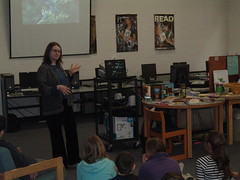
I graduated from college with no idea about what I wanted to do with my life. Well, I knew I wanted to write, but what kind of prospects are there for an untested writer in this world? I had gravitated towards journalism, mostly out of desperation for work, but once into the world of newspapers, I was hooked.
I loved the newsrooms, even with the cranky editors and odd-ball personalities. I loved hearing the roar of the presses, rumbling in the bowels of the building. I loved the deadline pressure, of writing with clarity. I loved my role as an eye on the community I covered. I loved how the newspaper was a meaningful part of the world, and how I was part of the newspaper that shone a light on that world. (OK, so I hated some of the way things were run and how some reporters became favorites of some editors, and I hated how some of my stories would get butchered by copy editors. It wasn’t all love and roses.)
I immersed myself totally into the history of journalism, devouring books about great reporters as if some of their qualities might rub off on me, and I took an avid interest in trade magazines, such as Editor & Publisher. And it soon became clear to me in the early 1990s, as it should have been clear to newspaper publishers (but apparently, was not), that the Internet was going to wreak total havoc on the profitability of newspapers (which mostly had monopolies in many cities and towns and which were incredibly profitable for many years). When the model of income is based almost entirely on advertising, and when you have the only game in town, you get lazy. And when you are lazy, the world can shift suddenly and dramatically. The Internet did that to newspapers.
As many colleagues of my former newspaper tell me, I got out of journalism to become a teacher just at the right time. Lay-offs have followed, cut-backs have ensued and the old newspaper where I cut my teeth as a writer is little more than a shell of itself these days. I can barely stomach reading it, when I do read it. It’s like watching someone you know and once cared about die a slow, painful death.
Which is exactly what Tom Rachman’s The Imperfectionists nails perfectly, as this wonderful debut novel sets its sights on a newspaper in Europe, and then performs the magic of delving deep into the people around that newspaper’s orbit — from reporters, to editors, to readers, to publishers. In the characters here, I saw many people I knew, including myself. The slow decline of the newspaper industry is laid bare in the tales of the people whose lives are pinned to writing and publishing the news.
Look at this passage, which comes near the end, as the publishing group that owns the newspaper makes the decision to fold the operation.
Newspapers were spiraling downward. Competing entertainments abounded, from cellphones to video games, from social networking sites to online porn. Technology was not merely luring readers; it was changing them. (245)
Rachman, who was a foreign correspondent himself, has a perfect ear for the voice of his characters, in all of those strengths and foibles. The chapters here are like short stories and each one could sit on its own. Woven together, however, the chapters are pitch-perfect. Like many in the real world, I hoped that the book might find some way for the newspaper to survive, so that these characters might endure. They don’t. The newspaper closes and their lives are uprooted. Just like in real life.
Peace (on the front page),
Kevin



